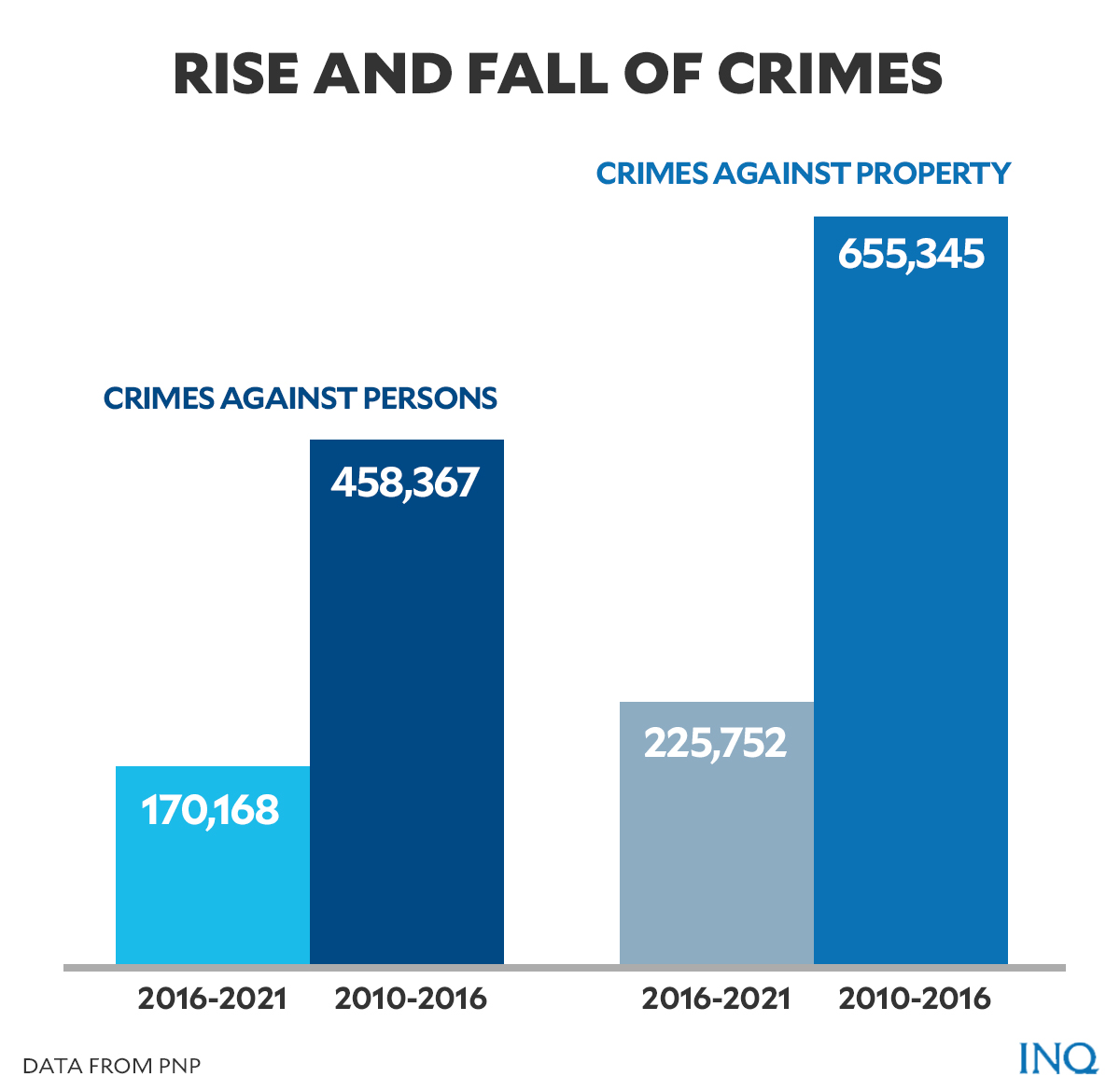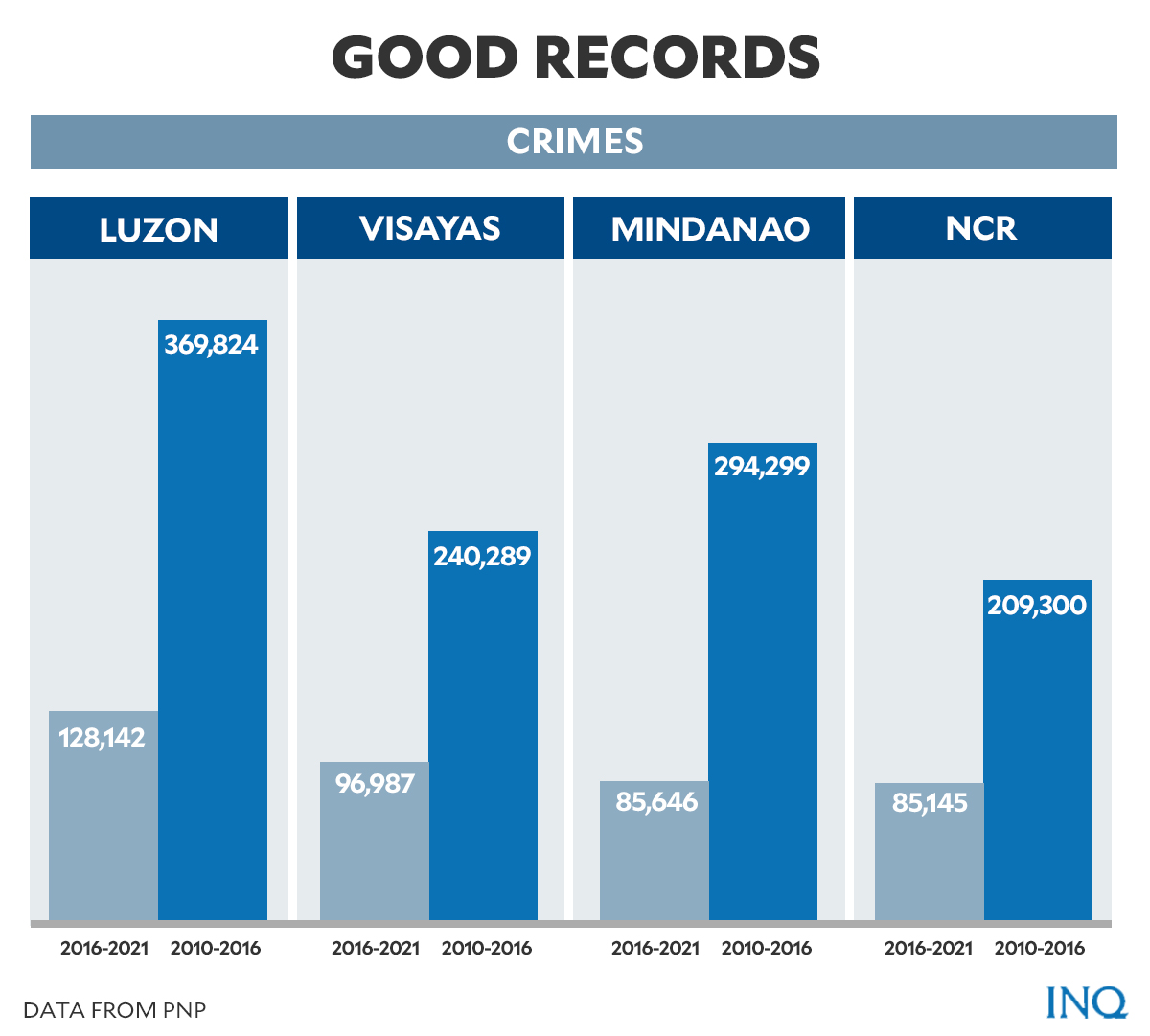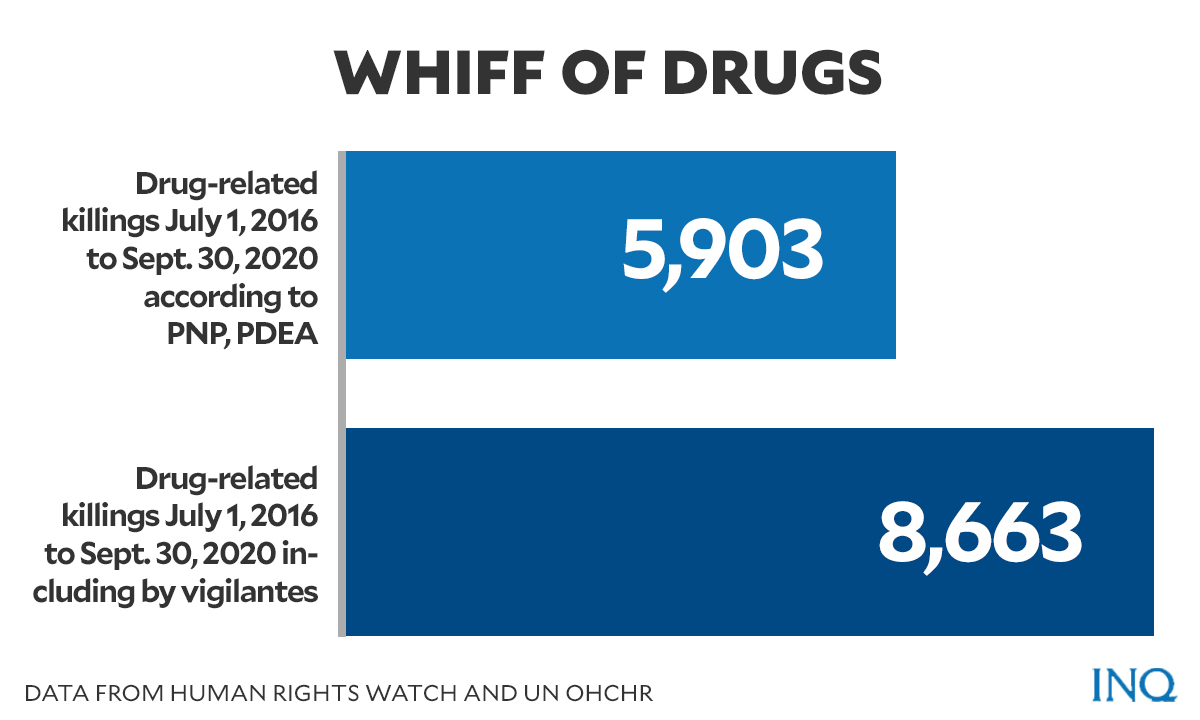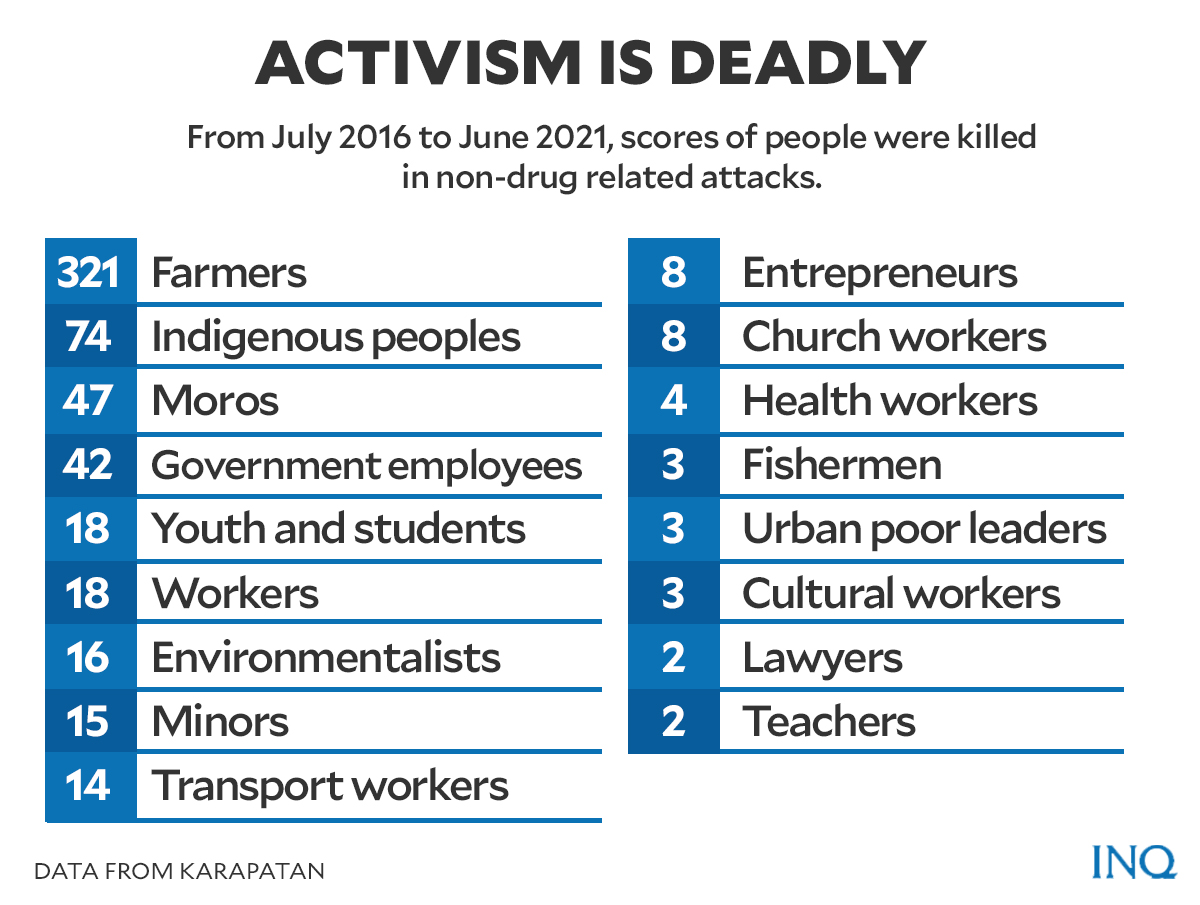In bid to make PH safe, killings become norm
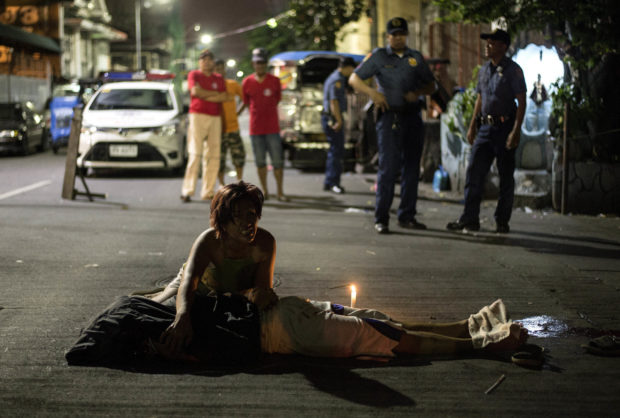
Nanette Castillo grieves over the dead body of her son Aldrin, an alleged drug user killed by unidentified assailants in Manila in this 2017 photo. —FILE PHOTO AFP
MANILA, Philippines—“I would rather intimidate and strike fear in the hearts of criminals. If it involves human rights, I don’t give a shit.”
This was what, according to a report by Washington Post, Philippine President Rodrigo Duterte said about his campaign against drugs and crimes in an interview with international news network Al Jazeera.
It was October 2016 as Duterte was just warming his seat as president.
Nearly five years after the former mayor of Davao City uttered those words, his national police and other security officials would say that Duterte’s iron-handed handling of crimes and drugs had been effective.
But there seems to be something amiss with what appears to be a bloodthirsty strategy to fight criminality and the drug trade.
Article continues after this advertisementA closer look showed there are two basic ways thousands of drug and crime suspects are getting killed—the first is through supposedly legitimate police operations and the second is through street executions by motorcycle-riding assassins.
Article continues after this advertisementSearch warrants had become the legal tool of most police raids that end in the killing of suspects inside their homes. It’s not clear what led to the killings but the official narrative is nanlaban, or suspects fighting back. Suspects who get killed in these operations, by logic, violently rejected a search of their homes.
READ: PNP can’t always fool public with ‘nanlaban’ claims – solons
The other way suspects are killed is through street executions by assailants on motorcycles. No knocking, no announcement of a police operation, just the echo of gunshots and motorcycles revving their way out of the kill zone.
Scare tactic it is. But it remains unclear if images of blood-soaked corpses strike fear in the hearts of only criminals.
READ: Don’t be surprised if drug suspects die fighting ‘trained to kill’ enforcers – Duterte
Duterte and his anti-crime enforcers have repeatedly given assurance to law-abiding civilians to not worry as only criminals are doomed to meet bloody ends.
But in many cases of the blood-spilling spiel, the dead are known only by their aliases or by the familiar police term “John Doe”, which means identity unknown.
This makes it difficult to know for sure if the dead belonged to either of two groups of people that Duterte had segregated based on his anti-crime strategy—the law-abiding and the law breaker.
READ: Drug war ‘spiraling out of control’
One instance of this was the case of 10 corpses abandoned in a Malabon City morgue in 2019. Caretakers said they were drug suspects but their names are not known and no one came to claim the bodies. Whether they were killed in police operations or by vigilantes in street executions was uncertain just as it is uncertain if those who killed these men were sure they were hitting the right targets.
As dead men tell no tale, no information could be had from the thousands of suspects who had been killed. The trail to the mastermind, the biggest criminal behind the Philippines’ illegal drug trade, has been erased by blood.
On the campaign trail in 2016, Duterte promised to end criminality within six months of his term.
READ: Duterte: Kill me if I fail to bust crime, corruption in 6 months
Five years later, however, this promise has yet to be fully fulfilled and crimes have taken on an added dimension—the killings that are not listed by police as crimes because they happened during official law enforcement operations.
READ: Duterte admits he was wrong on 3-6 months drug war deadline
With a year left to his reign, Duterte and his enforcers admitted crimes still exist but the outgoing administration fared much better than its predecessors.
The Philippine National Police (PNP) said 395,920 index crimes were reported nationwide from July 2016 to June 2021—a 64 percent decline from numbers during the late Benigno Aquino III’s administration—1,113,712.
Crimes against persons—murder, homicide, rape and physical injury –decreased by 62.87 percent from 458,367 to 170,168. Crimes against property—robbery, theft, carjacking and cattle rustling—also went down from 655,345 to 225,752, a decline of 65.55 percent.
Luzon, excluding Metro Manila, registered a 65.35 percent decline in crimes (369,824 to 128,142), Visayas crimes fell by 59.64 percent (240,289 to 96,987), Mindanao crimes fell by 70.90 percent (294,299 to 85,646) and crimes in the National Capital Region fell by 59.32 percent (209,300 to 85,145).
The numbers, however, do not reflect reality, according to Edre Olalia, president of the National Union of People’s Lawyers (NUPL).
People still “witness or are made aware by news of dastardly crimes brazenly committed with utter impunity,” he said.
‘Cold-blooded’
Since 2016, the government has been carrying out a campaign against drugs which the New York-based group Human Rights Watch (HRW) said targets mainly the poor in urban centers.
HRW cited official figures from the government, PNP and Philippine Drug Enforcement Agency (PDEA) showing that at least 5,903 individuals had been killed in government anti-drug operations from July 1, 2016 to Sept. 30, 2020.
The United Nations Office of the High Commissioner for Human Rights (OHCHR), however, said the figure could be closer to 8,663 including killings by so-called non-state actors, or vigilantes.
READ: Arming civilians: Idea follows PNP’s anti-crime success claim
Olalia said while killings by state security forces and “their proxies” are technically murders, these are not defined as such because those involved in the killings claim they were committed in the course of police operations. This “despite overwhelming testimonial, circumstantial and forensic evidence” that shows the killings were plain and simple cases of murder, Olalia said.
Llore Benedicto, mother of Crisanto and Juan Carlo Lozano who were killed in police drug operations in 2017, said that while there is a decline in crimes, the Philippines isn’t safe at all.
“The root of the problem was not solved, especially regarding illegal drugs, because the government only directed its attacks against the poor who were relentlessly killed,” she said in an interview with INQUIRER.net.
In 2020, the Social Weather Stations (SWS) released results of a survey saying Filipinos believed there had been a big drop in the number of drug users compared to July 2016, Duterte’s first month in office.
The same survey results, however, showed that 76 percent of adult Filipinos believe there had been violations of basic rights in Duterte’s anti-drug campaign.
Thirty-three percent said there were “many” violations, 42 percent said “somewhat many,” and 24 percent believed there were “few” violations.
Aside from those killed in “legitimate” anti-drug police operations, activists and lawyers were also targeted. Many were killed in brazen daylight attacks and others while they slept at night.
Since July 2016 to June 2021, human rights group Karapatan said hundreds of activists had been killed—321 farmers, 74 indigenous peoples, 47 Moros, 42 government employees, 18 youth and students, 18 workers, 16 environmentalists, 15 minors, 14 transport workers, 8 entrepreneurs, 8 church workers, 4 health workers, 3 fishermen, 3 urban poor leaders, 3 cultural workers, 2 lawyers and 2 teachers.
In the last five years, 62 lawyers, prosecutors and judges had been murdered, the highest death toll among members of the legal profession under all administrations that followed the Marcos dictatorship.
READ: Duterte admin has seen more lawyers killed than previous presidents – NUPL
Impunity in killings
Protests demanding accountability marked the last five years since the start of Duterte’s presidency. In the midst of the killings, Malacañang declared it was not deaf to the cry for justice and would order investigations.
Many teams had been formed to investigate—from an inter-agency panel to investigate drug-related killings to a task force to investigate political killings.
Last June 30, the Department of Justice (DOJ) said it has created a panel to evaluate drug-related police operations that led to the deaths of thousands of Filipinos, including children.
Justice Secretary Menardo Guevarra said in a speech at the 44th meeting of the United Nations Human Rights Council that the panel will come up with a report.
In May 2021, the PNP finally gave the DOJ access to 61 cases of police operations that led to suspects’ killing.
READ: Critics hit Duterte order limiting access to PNP drug war documents
Relatives of the dead, however, protested that the number of cases opened by PNP was “too small.”
Since 2016, only three police officers had been convicted of murder—Arnel Oares, Jeremias Pereda and Jerwin Crus—for the killing of 17-year-old Kian Delos Santos in a wrongful death case.
Malacañang had also said it would lead an investigation of killings of activists, including that of nine activists in simultaneous police and military raids in Calabarzon last March.
READ: UN ‘appalled’ by killing of 9 activists in Philippines
The PNP said it would investigate lapses in the operation that led to the killing of nine members of the Tumandok tribe accused of supporting communist insurgents in December 2020. Karapatan said no one had been prosecuted for the killings.
READ: Probe of 9 Tumandok leaders’ killings sought
Lean Porquia, son of activist Jory Porquia who was shot and killed inside his own home in Iloilo City on April 30, 2020, said there’s “no justice at all.”
“There was no justice to begin with,” said Lean.
“When my father was killed, we even had to beg from the police station to release all of his belongings,” he said.
READ: Activist shot dead in Iloilo City
“Not only did they serve injustice to my father, but they rendered themselves imbeciles and proved how lazy and mediocre they were,” said Lean.
Last March, as the killing of lawyers escalated, Malacañang said it would act to stop it and investigate without delay.
The Integrated Bar of the Philippines, however, said police solved only five of the killings while the rest had become cold cases.
Last July 14, Sitti Gilda Mahinay-Sapie became the 62nd lawyer killed under the Duterte regime. She and her husband were killed in Davao City, Duterte’s hometown.
Far from safe
In 2016, one of the most oft-repeated remarks from the President’s fanatics was that the Philippines will be safe like Singapore under Duterte. They equated Singapore’s phenomenal progress with authoritarian rule in the small city-state. What they did not mention was the other bigger reason that Singapore is now among the world’s wealthiest nations—the absence of corruption in high places and thievery in government.
For 23-year-old Rene Collado, a construction worker in Isabela province, the Philippines is far from being “like Singapore.”
The 2020 Global Law and Order Report by international polling firm Gallup said the Philippines was on the list of safest countries with a score of 84. Singapore, first on the list, got a score of 97.
That time, Presidential Peace Adviser Carlito Galvez Jr. said the government was glad that the Philippines was recognized as among the safest countries in the world. Months later, the Philippines would place last on the list of the Global Finance’s World’s Safest Countries 2021.
READ: PH ranks last in Global Finance’s list of world’s 134 safest countries
“We are far from safe and it is evident because we all know that crimes still exist in the Philippines,” said Collado in Ilocano.
“They say that there was a decline, but the fact that crimes still exist and that thousands still die, it means that threats still exist,” Collado said.
The Philippine Statistics Authority reported that in 2020, 6,008 individuals had been killed as a result of assaults—a 37.4 percent decline from numbers in 2019—12,000.
While the chance of getting killed is not the only gauge of a country’s safety, the rate of killings in the Philippines could be a source of concern for not only those being suspected of crimes.
Although corpses turn up only in mainly blighted communities, there’s no telling if they’ll one day end up in front of a gleaming building on Ayala Avenue, the main road of the Philippines’ business hub, Makati City. The same gruesomeness but different levels of impact.
The killings could be a mirror of the contempt for human rights by Duterte himself and his enforcers. The benefits of shock value would be debatable.
It is important to learn from history, however. While respect for human rights is essential to a civilized nation, its disregard has been shown to precede tyrannies and is a mark of banana republics.
Why human rights is basic in a civilized society can be best explained by what Mother Teresa, now a saint, said about it: “Human rights are not a privilege conferred by government. They are every human being’s entitlement by virtue of his humanity.”

